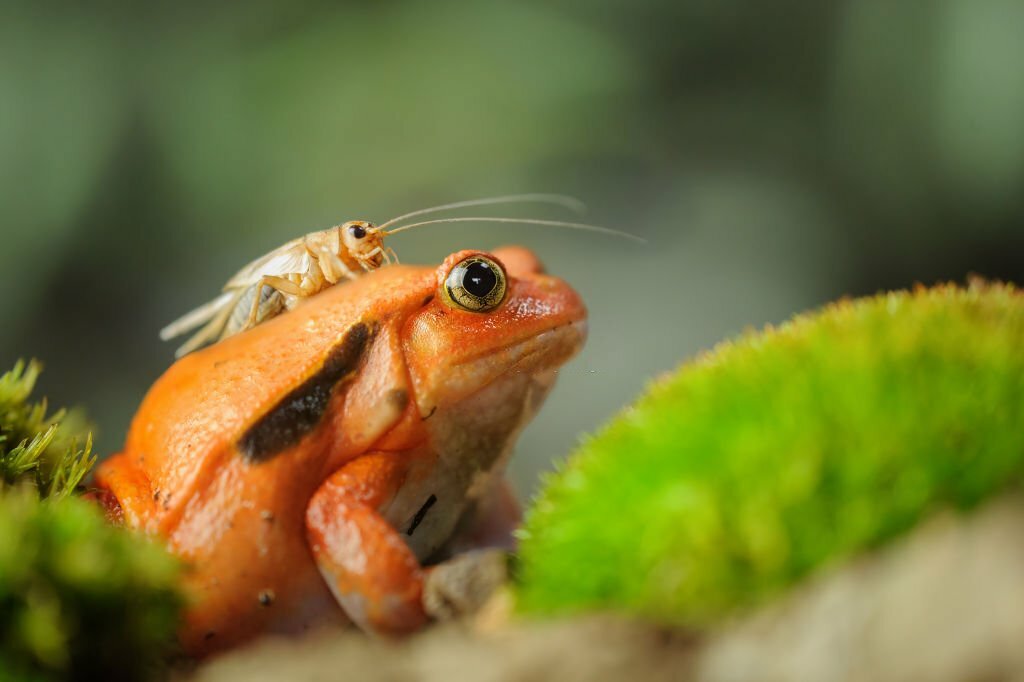Introduction to Cohabiting Tomato Frogs
Cohabiting tomato frogs refers to the practice of keeping multiple tomato frogs together in a shared habitat. This can be an appealing option for frog enthusiasts as it allows for a dynamic and interactive frog community. However, before diving into cohabiting tomato frogs, it is important to understand the benefits and drawbacks involved. In this article, we will explore the pros and cons of cohabiting tomato frogs, factors to consider before making this decision, and best practices to ensure the well-being of your frogs. Whether you are a beginner or an experienced frog keeper, this article will provide valuable insights on cohabiting tomato frogs.

Advantages of Cohabiting Tomato Frogs
Cohabiting tomato frogs can offer several advantages for frog keepers and enthusiasts. Here are the key benefits of keeping tomato frogs together:
Social Interaction
Tomato frogs are social creatures, and keeping them cohabited allows them to engage in natural social behaviors. They can interact with each other, forming social bonds and providing mental stimulation.
Mimicking Natural Habitat
In the wild, tomato frogs are often found in close proximity to each other. By cohabiting with them, you can recreate a similar environment that mimics their natural habitat. This can contribute to their overall well-being and reduce stress.
Space Efficiency
Cohabiting tomato frogs can be more space-efficient, as it allows you to house multiple frogs in a single enclosure. This can be particularly beneficial when you have limited space or want to create a visually appealing display.
Ease of Observation
Having multiple tomato frogs in one enclosure makes it easier to observe their behavior and study their interactions. This firsthand observation provides valuable insight into the frogs’ social dynamics and individual personalities.
Potential for Breeding Success
Cohabiting tomato frogs can increase the chances of successful breeding. By housing males and females together, you create a conducive environment for courtship and reproduction. However, it’s important to carefully monitor the frogs during breeding to ensure their safety.
When considering the advantages of cohabiting tomato frogs, it’s crucial to keep in mind the appropriate housing size and consider factors such as sex ratios, compatibility, and individual health. As with any frog-keeping practice, it’s recommended to follow the best practices outlined by experts to ensure the well-being of your tomato frogs.
Disadvantages of Cohabiting Tomato Frogs
Cohabiting Tomato Frogs can be a great way to create an interactive and visually appealing habitat. However, there are certain disadvantages associated with this practice that should be considered before making the decision to house multiple tomato frogs together.

Increased Risk of Aggression
One of the main drawbacks of cohabiting tomato frogs is the potential for aggression. Tomato frogs are generally known for being solitary and territorial creatures. When housed together, they may exhibit aggressive behaviors, such as territorial disputes or even physical harm to one another. This aggression can ultimately lead to stress, injuries, or even death among cohabiting tomato frogs.
Competition for Resources
Cohabiting tomato frogs might have to compete for essential resources like food, water, hiding spots, and breeding sites. Limited availability of resources can potentially result in malnutrition, dehydration, or the inability to reproduce successfully. It is crucial to ensure that each frog has access to an adequate amount of resources in a cohabited setup.
Spread of Diseases and Parasites
Keeping multiple tomato frogs in close proximity increases the likelihood of diseases and parasites spreading among the individuals. A single sick frog can easily transmit illnesses to other frogs in the same habitat. Moreover, some parasites, such as mites or fungus, can thrive in damp environments commonly found in cohabited setups. Regular health checks and appropriate hygienic measures are essential to minimize the risk of disease transmission.
Difficulty in Monitoring Individual Health
When tomato frogs are cohabited, it becomes more challenging to monitor each frog’s health on an individual basis. Certain signs of illness or stress may go unnoticed when frogs are housed together. This can lead to delays in identifying and addressing health issues promptly. Regular health inspections and separating any sick or injured frogs should be prioritized to maintain their well-being.
Although there are disadvantages to cohabiting tomato frogs, it is possible to minimize these risks by following a few best practices. Creating a spacious habitat with ample resources, monitoring individual health closely, and providing hiding spots for privacy can help mitigate the negative effects of cohabitation. However, it is vital to carefully weigh these disadvantages against the benefits and consider the temperament and needs of individual tomato frogs before deciding to cohabitate them.
Factors to Consider Before Cohabiting Tomato Frogs
Species Compatibility
Before cohabiting tomato frogs, it is crucial to consider the compatibility of the species you plan to house together. Different species have varying needs and behaviors, which may impact their ability to coexist peacefully.
Size and Age
Size and age differences between tomato frogs may affect their interactions. It is generally recommended to house frogs of similar sizes, as larger frogs may intimidate or accidentally harm smaller ones. Similarly, introducing young tomato frogs to older individuals may result in aggression or dominance issues.
Tank Size and Layout
Providing an adequately sized tank is essential when housing tomato frogs together. A spacious environment with ample hiding spaces and separate feeding areas helps minimize competition and stress among cohabiting frogs.
Feeding and Nutrition
Consider the dietary needs of tomato frogs before deciding to cohabit them. It is crucial to ensure that all frogs receive sufficient food and nutrients. Monitoring feeding behavior and adjusting feeding schedules may be necessary to avoid food shortages or overeating.
Territorial Behavior
Tomato frogs can be territorial, especially during breeding season. Evaluating the territorial behavior and aggression levels of individual frogs is vital to prevent conflicts and potential injuries when cohabiting with them.
Health and Quarantine
Ensure that all tomato frogs intended for cohabitation are healthy and free from any infectious diseases. Quarantine new frogs before introducing them to an existing group to minimize the risk of spreading illnesses.
Monitoring and Observation
Constant monitoring and observation are essential when cohabiting tomato frogs. Regularly watch for any signs of aggression, stress, or illness among the frogs. Promptly addressing any issues can help ensure a harmonious cohabitation.
Expert Recommendations
Consult with experienced amphibian keepers or reputable sources to gather more information and expert recommendations specific to the species of tomato frogs you intend to cohabit. Their expertise can provide valuable insights into potential challenges and best practices.
Remember, always prioritize the well-being and safety of the tomato frogs when considering cohabitation.

Cohabiting Tomato Frogs: Best Practices
When it comes to cohabiting tomato frogs, following best practices is essential to ensure the well-being of the frogs and create a harmonious living environment. By taking certain precautions and considering the specific needs of tomato frogs, you can enhance their cohabitation experience. Here are some best practices to follow:
- Provide adequate space: Tomato frogs require sufficient space to move around comfortably. A suitable enclosure should have enough floor space, as well as vertical space for climbing and hiding. Aim for a minimum of 10 gallons per frog when cohabiting.
- Use a neutral territory: Before introducing tomato frogs to a shared enclosure, it’s essential to create a neutral territory where the frogs can meet and get accustomed to each other’s presence. This can help minimize territorial behavior and aggression.
- Monitor for compatibility: Regularly observe the frogs’ behavior when they are first introduced. Note any signs of aggression, such as chasing, biting, or incessant calling. If any conflicts arise, separate the frogs immediately to avoid injuries.
- Provide multiple hiding spots: Tomato frogs appreciate hiding places to retreat to when they feel stressed or threatened. Offer an ample number of hiding spots, such as cork bark, plants, or hollow logs, to make each frog feel secure and minimize territorial disputes.
- Offer varied food sources: Tomato frogs have unique dietary requirements, and it’s important to provide a diverse range of suitable food sources. Offer a balanced diet of gut-loaded insects, such as crickets and roaches, supplemented with occasional dusted worms or fruit flies.
- Regularly clean the enclosure: Maintaining a clean and hygienic enclosure is crucial for tomato frog health. Clean the habitat regularly, removing any uneaten food, feces, or stale water to prevent the growth of harmful bacteria or parasites.
- Seek expert advice when uncertain: If you have any doubts or concerns about cohabiting tomato frogs, it’s advisable to consult an experienced herpetologist or veterinarian who can provide specific guidance based on your unique situation.
Remember, while cohabiting tomato frogs can be successful, it’s important to closely monitor their behavior, ensure their needs are met, and be prepared to separate them if any conflicts arise. By following these best practices, you can create a harmonious and enriching environment for your cohabiting tomato frogs.
Signs of Compatibility or Incompatibility
When determining the compatibility or incompatibility of tomato frogs in a cohabitation setup, it’s essential to observe their behaviors and reactions towards each other. While every frog is unique, there are certain signs that can help you assess whether they will get along or not. Here are some key indicators to look out for:
- Aggression: Aggression between tomato frogs is an obvious sign of incompatibility. Aggressive behaviors may include chasing, biting, or attacking each other. If you notice any signs of aggression, it’s best to separate the frogs immediately to prevent injury.
- Territoriality: Tomato frogs are known to be territorial creatures. If you notice two frogs constantly trying to claim the same space or defending certain areas within their enclosure, it could be a sign of incompatibility. Territorial disputes can lead to stress and fights between the frogs.
- Vocalizations: Tomato frogs may emit vocalizations like croaking or screaming. While occasional vocalizations are normal, incessant and intense vocalizations may be a sign of aggression or distress. Pay attention to the frequency and intensity of the vocalizations to determine if the frogs are compatible.
- Body Posture: Observe the body posture of the frogs when they are together. Relaxed and open postures, with both frogs sitting comfortably and not displaying signs of stress, are indicators of compatibility. Conversely, if one frog appears tense or is displaying defensive postures, it could be a sign of incompatibility.
- Feeding Behavior: Take note of how the frogs behave during feeding time. If they are willing to eat together without aggression or competition, it suggests a certain level of compatibility. However, if one frog consistently dominates or prevents the other from accessing food, it may indicate an incompatible pairing.
Conclusion and Expert Recommendations
In conclusion, cohabiting tomato frogs can be a rewarding experience for frog enthusiasts, as it allows for social interaction, mimics natural habitat, saves space, facilitates observation, and increases the potential for breeding success. However, it is important to consider the disadvantages, such as increased risk of aggression, competition for resources, spread of diseases and parasites, and difficulty in monitoring individual health.
Before deciding to cohabitate tomato frogs, it is crucial to consider factors such as species compatibility, size and age differences, tank size and layout, feeding and nutrition, territorial behavior, health and quarantine, and regular monitoring and observation. Following these best practices, including providing adequate space, creating a neutral territory, offering multiple hiding spots, providing varied food sources, regularly cleaning the enclosure, and seeking expert advice when necessary, can help ensure the well-being of cohabiting tomato frogs.
When assessing the compatibility or incompatibility of tomato frogs in a cohabitation setup, it is important to monitor their behavior for signs of aggression, territoriality, vocalizations, body posture, and feeding behavior. Promptly separating incompatible frogs can prevent injuries and maintain a harmonious environment.
Overall, cohabiting tomato frogs can be a rewarding and enriching experience when approached with careful consideration and adherence to best practices. By prioritizing the well-being and safety of the frogs, frog keepers can create a vibrant and interactive community of tomato frogs.


